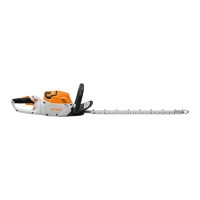► Keep the battery dry. Protect it from
rain, water, liquids and damp condi‐
tions.
► Never immerse the battery in water
or other liquids.
►
Never bridge the battery terminals with
wires or other metallic objects.
► Keep a battery that is not in use away from
small metal objects capable of conducting
electricity (e.g., paper clips, nails, coins,
keys).
►
Store the battery indoors in a dry room.
► Never store the battery in damp or corro‐
sive environments or in conditions that
could lead to corrosion of its metal compo‐
nents.
►
Never store the battery in the hedge trim‐
mer.
► When storing the battery, maintain a charge
of 40 % to 60 % (2 green LEDs).
► If storing the battery in the charger, discon‐
nect the charger from the outlet.
► Protect the battery from exposure to corro‐
sive agents such as garden chemicals and
de-icing salts.
►
Protect the battery from exposure to con‐
ductive liquids such as salt water.
► Do not attempt to repair, open or disassem‐
ble the battery. There are no user-servicea‐
ble parts inside.
■
Leaking battery fluid is potentially harmful and
can cause skin and eye irritation, chemical
burns and other serious personal injury.
►
Avoid contact with skin and eyes.
► Use an inert absorbent such as sand on
spilled battery fluid.
► In the event of accidental contact, immedi‐
ately rinse the contact area thoroughly with
mild soap and water.
►
If fluid gets into your eye(s): Do not rub.
Rinse water over the open eye(s) for at
least 15 minutes and seek medical atten‐
tion.
■
A battery fire can be dangerous. To reduce the
risk of severe personal injury and property
damage in the event of fire:
►
Evacuate the area. Fire can spread rapidly.
Stay clear of any vapors generated and
maintain a safe distance.
►
Contact the fire department.
► Although water can be used to put out a
battery fire, use of a multi-purpose dry
chemical fire extinguisher is preferable.
►
Consult the fire department regarding
proper disposal of a burned battery.
■ Dropping the battery could result in personal
injury or property damage. To prevent the bat‐
tery from falling during removal:
►
Place the hedge trimmer on a level surface.
► Use care when ejecting the battery.
8 Charger Safety
8.1 Warnings and Instructions
WARNING
■ To reduce the risk of fire, electric shock and
other personal injury or property damage:
► Read and follow all cautionary markings on
the charger, battery and hedge trimmer and
all instructions in this manual before using
the charger.
►
Charge only genuine STIHL AK or STIHL
AP series batteries. Other batteries may
burst, catch fire or explode, resulting in per‐
sonal injury and property damage.
► For indoor use only.
► Keep the charger dry. Protect it from
rain, water, liquids and damp condi‐
tions. Never insert a wet battery or
use a wet charger.
►
Do not handle the charger, including power
supply cord and plug, with wet hands.
► Never use a damaged charger.
► Never charge malfunctioning, damaged,
cracked, leaking or deformed batteries.
► When storing the battery, maintain a charge
of 40 % to 60 % (2 green LEDs).
► If storing the battery in the charger, discon‐
nect the charger from the outlet.
► Operate the charger only indoors, in dry
rooms.
► Operate the charger only within the speci‐
fied ambient temperature limits, 24.5.
► Keep the charger out of the reach of chil‐
dren.
► Always plug the charger into a properly
installed electrical outlet matching the volt‐
age and electrical frequency stated on the
charger.
►
If too many devices are connected to a
power strip, electrical components can be
overloaded during charging, leading to
overheating and fire. If using a power strip,
never exceed its total capacity.
►
Do not operate a charger that has received
a sharp or heavy blow, has been dropped
or is otherwise damaged in any way.
►
Do not attempt to repair, open or disassem‐
ble the charger. There are no user-service‐
able parts inside.
English 8 Charger Safety
12 0458-019-8201-A

